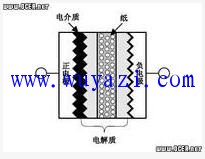Introduction Electrolytic capacitors are a kind of medium for capacitors. Electrolyte coatings have polarities, which are positive and negative. Electric capacity consists of two metal poles with an insulating material (medium) interposed therebetween. 
Features Electrolytic Capacitor Features 1: The capacitance per unit volume is very large, tens to hundreds of times larger than other types of capacitors.
Electrolytic capacitors feature two: the rated capacity can be very large, can easily achieve tens of thousands of μf or even a few f (but not with the double layer capacitance).
Electrolytic capacitors have three characteristics: the price is overwhelmingly superior to other types, because the constituent materials of electrolytic capacitors are common industrial materials, such as aluminum. The equipment for manufacturing electrolytic capacitors is also an ordinary industrial equipment, which can be mass-produced and has relatively low cost. Common Japanese electrolytic capacitors are represented by Nippon Chemi-con, Nichicon, Rubycon, Matsushita, Hitachi, and Taiwanese capacitors are represented by OST, TAICON, TEAPO, and CAPXON.
Principle Electrolytic capacitors are usually made of metal foil (aluminum/bismuth) as a positive electrode, an insulating oxide layer of aluminum foil (aluminum oxide/yttrium oxide) as a dielectric, and electrolytic capacitors are divided into aluminum electrolytic capacitors and tantalum by their positive electrodes. Electrolytic capacitors. The negative electrode of the aluminum electrolytic capacitor is composed of a thin paper/film or an electrolyte polymer immersed in an electrolyte liquid (liquid electrolyte); the negative electrode of the tantalum electrolytic capacitor is usually manganese dioxide. Since the electrolyte is used as the negative electrode (note that it is distinguished from the dielectric), the electrolytic capacitor is named after it.
The application of polar electrolytic capacitors usually functions as power supply filtering, decoupling, signal coupling, time constant setting, and DC blocking in the power supply circuit or the intermediate frequency and low frequency circuits. Generally, it can not be used in the AC power supply circuit. When used as a filter capacitor in the DC power supply circuit, the anode (positive electrode) should be connected to the positive terminal of the power supply voltage, and the cathode (negative electrode) should be connected to the negative terminal of the power supply voltage. Otherwise it will damage the capacitor.
Non-polar electrolytic capacitors are commonly used in speaker divider circuits, television S correction circuits, and start-up circuits for single-phase motors.
Electrolytic capacitors are widely used in household appliances and various electronic products. Their capacities range from 1 to 1000 μF and rated operating voltages range from 6.3 to 450V. The disadvantage is that the dielectric loss and the capacity error are large (the maximum allowable deviation is +100%, -20%), the high temperature resistance is poor, and the storage time is long and easy to be invalid.
Mono Solar Panel
Anti-reflective coating: AR used reduces the reflectivity to enhance transmittance.
Tempered Glass: Low Iron and AR coating glass increase the power output and mechanical strength of the solar module. Mechanical load ≥2400Pa, transmittance ≥91.6%
EVA: Transmittance ≥91%, Adhesive Capacity >85%
Cell: 17.9% of high-efficiency solar cells to sure 15.7% module efficiency
Back sheet: Using higher quality back sheet to prevent destroying and water, it`s reflectivity ≥87%, peeling strength ≥ 40N/cm.
Aluminum Frame: Anodized aluminum alloy to effectively improve the corrosion resistance and strength
Mono Cell Solar Panel,Monocrystalline Module,Perc Mono Solar Panel,Monocrystalline Solar Panel Price
Wuxi Sunket New Energy Technology Co.,Ltd , https://www.sunketsolar.com
